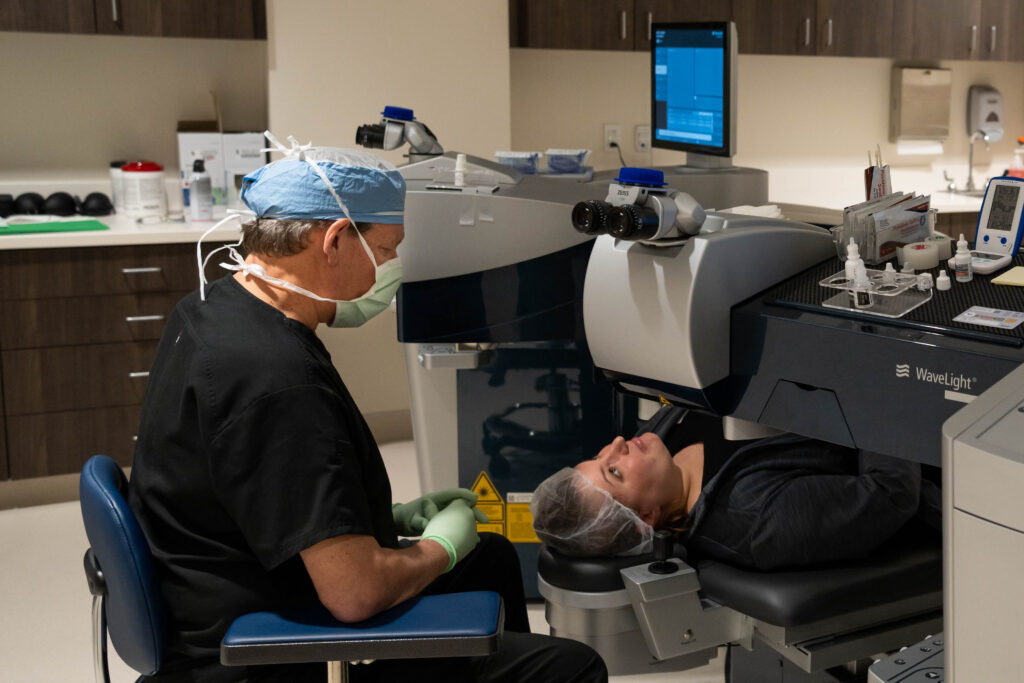
Before LASIK
We will discuss your vision needs based on your lifestyle. For example, if you play sports, you may be seeking clear distance vision from surgery.
We will start with a consultation visit with Dr. Polk to exam your eyes to determine if you are a good candidate for LASIK.
- Test your vision. This is to make sure that your vision has not changed. It also shows how high your refractive error is and whether LASIK can be used to correct your vision.
- Check for other eye problems. We will make sure that you do not have eye problems. This is because other problems could affect your surgery, or LASIK could make those other problems worse. For example, if you have dry eyes, they may be worse after LASIK.
- Measure and map the surface of your cornea. Next we will check the thickness of your cornea and make precise measurements of the cornea’s surface. Your eye surgeon uses these measurements to program the computer-based laser used during surgery.
- Measure your pupil size. Dr. Polk will also measure the size of your pupil. If your pupil is very large, you could see halos (rings of light) at night after LASIK.
During LASIK
Dr. Wexler will use a cold laser to reshape your cornea. Here is what to expect:
- Your eye will be numbed with eye drops.
- Your eye surgeon will place an eyelid holder on your eye to keep you from blinking. He or she will also place a suction ring on your eye to keep it from moving. You will feel pressure like a finger pressing firmly on your eyelid. At this point, your vision will go dim or black.
- Using a laser, Dr. Wexler makes a paper-thin flap in the cornea tissue. Then he lifts and folds the flap back.
- You will be asked to stare at a target light so that your eyes will not move. Dr. Wexler then reshapes your cornea using a laser. The laser is a special instrument that has been programmed with measurements for your eye.
- While the laser is in use, you will hear a clicking sound. After reshaping the cornea, your eye surgeon folds the flap back down into position and smoothes the edges. The flap attaches on its own in 2–3 minutes, where it will heal in place.
After LASIK
- Your vision may be foggy the day after surgery but should improve with time.
- Keep you eyes closed in the car and wear sunglasses/goggles.
- You should plan to go home and take a nap or just relax after the surgery.
- For a few hours, your eyes may feel scratchy or feel like they are burning. You will be given special eye drops to reduce dryness and help your eye heal.
- It is important to attend all of your post-operative appointments to monitor your healing process.
Vision after LASIK
About 90% people who have LASIK end up with vision between 20/20 and 20/40—without glasses or contact lenses.
It is important to know that LASIK cannot correct presbyopia. This is the normal, age-related loss of close-up vision. With or without refractive surgery, almost everyone who has excellent distance vision will need reading glasses after around age 40.
To help with presbyopia, some people have LASIK to get monovision. This means one eye is left slightly nearsighted and the other eye is adjusted for distance vision. The brain learns to adapt so that the nearsighted eye is used for close work, while the other eye sees distant objects. Monovision is not for everyone. To see if you are able to adapt to this correction, you will probably want to try monovision with contact lenses first.